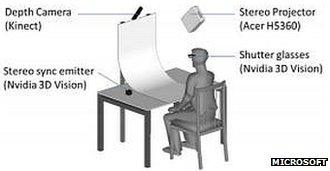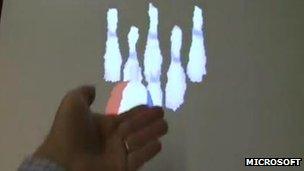MirageTable: Microsoft presents augmented reality device
- Published

Researchers used the device to collaborate on how to build an object out of blocks
Microsoft has shown off an augmented reality system that allows users at different locations to work together on tabletop activities, sharing objects which they can both handle.
The MirageTable was demonstrated at a conference in Austin, Texas and is <link> <caption>outlined on the firm's research site</caption> <url href="http://research.microsoft.com/en-us/um/people/benko/publications/2012/MirageTable_CHI2012.pdf" platform="highweb"/> </link> .
Researchers said it could "fool" the eye to suggest both parties were using a "seamless 3D shared task space".
The team admitted more work was needed before the system could be marketed.
Avoiding bulky equipment
The MirageTable uses a 3D-video projector to beam images onto a sheet of curved white plastic placed in front of the user.
At each end one of Microsoft's Kinect depth camera sensors is used to track the direction of each person's gaze as well as to capture the shape and appearance of objects placed on the surface and the participant sitting behind them.
Users are also required to wear shutter glasses in order to see the projected image in three dimensions. Two computers linked by a network connection are required to power the experience.
The researchers said they were "motivated by a simple idea: can we enable the user to interact with 3D digital objects alongside real objects in the same physically realistic way and without wearing any additional trackers, gloves or gear."

Block building
They claimed success stating that the experience was a significant improvement on current video conferencing technologies.
"In our system, the user can hold a virtual object, move it, or knock it down, since all virtual and real objects participate in a real-world physics simulation... The unique benefit of this setup is that two users share not only the 3D image of each other, but also the tabletop task space in front of them."
A <link> <caption>video posted online</caption> <url href="http://www.youtube.com/watch?v=EaCjTog0u40" platform="highweb"/> </link> shows two people working at different locations to build an object out of blocks, with one researcher measuring the distance between the pieces placed by the other participant.
A research paper also noted that the technology could be used to create a single-person gaming experience.
It said that a scan of a single bowling pin could be used to create multiple objects projected in front of the user. These can then be knocked down with a virtual bowling ball using a physics simulation built into the system.
Unresolved problems

The researchers showed that the set-up could also be used to allow virtual reality bowling
However, the researchers admitted that the project was far from perfect.
At present the Kinect device only captures the front face of objects, leaving gaps and imperfect texturing. The technicians suggested that this could be fixed by using additional cameras.
The set-up also only allows users to scoop or catch objects from below in order to hold them in their hands.
"Simulating realistic grasping behaviours given depth camera input remains an open research problem," the researchers admitted.
"While we are still very far from an implementation of a working version of Star Trek's Holodeck, MirageTable shows the potential of the projector/depth camera system to simulate such scenarios."
- Published8 March 2012
- Published28 October 2011